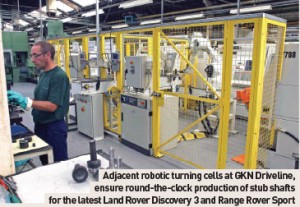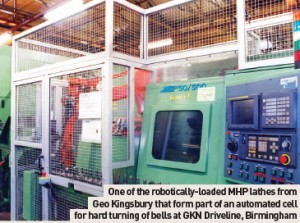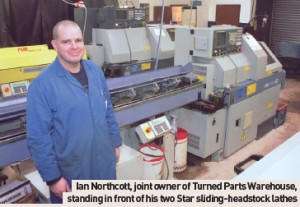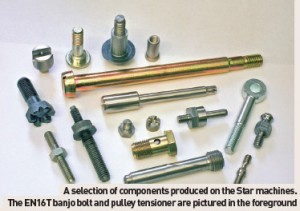
Major OEMs are turning to the expertise of established Tier One machine makers to meet time critical lathing needs
While OEMs carry out a lot of their machining in-house, there is still a huge amount that is handed out to major Tier One manufacturers around the globe. Traditionally, the high volume, long-established items have been shipped to the low-cost manufacturing economies of Eastern Europe and the Far East.
This seemingly simply strategy is problematic however, plagued with long-lead times, an extended supply chain and the inability to react to problems or changes in manufacturing patterns. But lately, with the aid of automation and high-specification machine tools, the Tier Ones in established markets have been fighting back.
The ability to fill shortages or react to changes in part specifications has made these suppliers invaluable.
 At GKN Driveline in Birmingham they use both Motoman and ABB robots to maximise the efficiency of their machining operations.
At GKN Driveline in Birmingham they use both Motoman and ABB robots to maximise the efficiency of their machining operations.
For the manufacture of propshafts for the Land Rover Discovery 3 and Range Rover Sport, GKN Driveline in Walsall has installed two automated turning cells. Each comprises a pair of Mazak lathes loaded and unloaded by a Motoman articulated-arm robot, plus conveyors and handling equipment. Replacing two operators working around the clock in shifts, the robots, with one operator in attendance, are making savings that will pay for the capital cost of the robots and their integration.
“We had been looking at automation for some time, but one needs relatively large volumes to justify the investment,” Alan Sellman, Project Engineer at GKN Driveline, says. “Then the Range Rover contract came along, which was ideal for automation, so we decided to take the plunge. We are currently producing 14,000 stub shafts per week in the two cells, which are the first lathes on the Walsall site to use stand alone robots.”
A sister GKN Driveline factory in the US uses over 200 Motoman robots to tend a variety of machine tools, which persuaded the Walsall production engineering team to approach the UK operation for the supply of two naked UP20s, which were integrated by Sellman and his colleagues to feed both pairs of Mazak Nexus 250 lathes.
GKN Driveline Walsall was similarly responsible for the acquisition and design of peripheral equipment including robot grippers mounted on ‘quickstops’ that dislocate in the event of collision. They are also responsible for all conveyors and a one-in-10 sampling arrangement for quality control with automatic return of the tested part to the production conveyors using the robots’ idle time.
 Safety measures include an interlock to ensure that a robot cannot crash into a manual control pendant should one be left adjacent to the output conveyor or a machine door inside a cell. They also involve the use of a NetOp wireless remote networking system that allows adjustments to operating parameters to be made from outside the cell while production is in progress.
Safety measures include an interlock to ensure that a robot cannot crash into a manual control pendant should one be left adjacent to the output conveyor or a machine door inside a cell. They also involve the use of a NetOp wireless remote networking system that allows adjustments to operating parameters to be made from outside the cell while production is in progress.
All machining on the CK 45 billets in the lathes are rotational, there being no milling content. Machined components that emerge from the automated turning cells are routed first to spline rolling and on to induction hardening, without any manual intervention.
“The robots in the automated turning cells have not missed a beat since they were installed,” Sellman adds. “We have employed robots within the welding process here for many years and following the success of this machine tending application, it is likely that more automated handling projects will follow.”
On the machine tool front, since 1998 the company have installed 25 UK-built lathes from the MHP division of Geo Kingsbury Machine Tools for hard- and soft-turning transmission components, many of these replacing grinding operations.
Most recently, a robotically loaded MHP50 CNC lathe has been built for hard turning critical features on the constant velocity joint, or bell, that forms part of frontwheel and four-wheel driveshafts. There were already five robot-fed MHP machines on the Birmingham site being used for similar work, each teamed with other machinery including hardening, spline rolling, washing plant to form automated manufacturing cells for outer race constant velocity bells. Production rate is 1,400 components per cell per shift with five operators.
Each automated MHP lathe is fitted with its ABB robot at Geo Kingsbury’s Gosport factory and is supplied, after pass-off, to GKN as a turnkey package, complete with programs. The other MHP lathes are in manually loaded cells for soft turning operations on bells and tulips, the latter forming part of the plunging joint in a driveshaft nearer to the gearbox.
Mike Poyner, the engineer responsible for project managing the new production cells at the Birmingham factory, said: “It is our policy to replace as many grinders as possible with hard turning. Each time a lathe is installed it replaces pairs of external, angle-approach grinders.
By doing this, there is a six-fold saving in capital investment, amounting to several hundred thousand pounds.
“Also, it takes two hours to change over an external grinder for a new batch compared to 10 minutes for a lathe, so production downtime is less by a factor of 12.”
 Driving the original change from grinding to hard turning were difficulties with grinding the hub support diameter of the bell, and more particularly a shoulder called the ‘back location face’, both of which are pre-hardened to 58 - 62Rc. The main problem used to be cracking of the location face during grinding, caused by overheating owing to difficulty in projecting sufficient coolant between the grinding wheel and the vertical face. The earlier grinding operation and the dry hard-turning sequence that has replaced it includes in-cycle machining of a third OD in an unhardened state of 45 - 48Rc, namely a seating diameter for an ABS pulse ring.
Driving the original change from grinding to hard turning were difficulties with grinding the hub support diameter of the bell, and more particularly a shoulder called the ‘back location face’, both of which are pre-hardened to 58 - 62Rc. The main problem used to be cracking of the location face during grinding, caused by overheating owing to difficulty in projecting sufficient coolant between the grinding wheel and the vertical face. The earlier grinding operation and the dry hard-turning sequence that has replaced it includes in-cycle machining of a third OD in an unhardened state of 45 - 48Rc, namely a seating diameter for an ABS pulse ring.
As all turned features need to be concentric with six internal ball tracks, drawing tolerances are tight: ± 0.013 mm for the hub support diameter and ± 0.015 mm for the ABS diameter; the surface finish for both being 1.6 μm. As regards the back face, 0.15 mm of material is machined away to leave a 0.8 μm surface finish. The Ra figures achieved in practice are significantly lower than these. Process capability achieved is Cpk 3.66 for the hub support diameter and Cpk 2.65 for the ABS diameter – significantly better than the required Cpk of 1.67 (5 Sigma).
More recently, GKN Driveline has been working in conjunction with Geo Kingsbury to identify inserts for soft turning that would last longer and reduce cycle times. When machining a bell in its soft state, the incumbent supplier’s insert used to result in a 65-second turning cycle and it lasted for 70 components. After research and subsequent trials, a Kennametal insert reduced the cycle to 55 seconds and was found to machine nearly three times as many parts before it needed replacing. Poyner described the improvement as a “step change”.
Not far away, Coventry-based Turned Parts Warehouse, set up in 2003, has enjoyed considerable business success with its three CNC sliding-headstock lathes, two of them from Star Micronics GB. The machines, which operate continuously throughout the year, have allowed the subcontractor to win automotive work from Chinese and Taiwanese suppliers, which anecdotal evidence suggests are increasingly letting down direct line feeders that supply components straight to the production lines of major automotive manufacturers in the UK.
 A complete stoppage at Nissan’s Sunderland plant costs the company £6,000 ($11,000) per minute, so it is crucial that components of the correct quality are supplied on time. While unit production costs are low in the Far East, lead-time is typically long at six to eight weeks, five of which are spent shipping the components.
A complete stoppage at Nissan’s Sunderland plant costs the company £6,000 ($11,000) per minute, so it is crucial that components of the correct quality are supplied on time. While unit production costs are low in the Far East, lead-time is typically long at six to eight weeks, five of which are spent shipping the components.
“Most of the time the system works, but occasionally the wheels fall off,” Tim Bayliss, Turned Parts Warehouse joint owner, explains. “Suddenly the direct line feeder finds that parts have not arrived or are out of tolerance, and we receive an urgent request for a relatively small quantity of a few thousand components to be delivered in a couple of days.”
He cited a recent example where a line feeder realised on a Wednesday afternoon that a car production line would run out of 5BA square nuts within 24 hours. The drawing was faxed through to Turned Parts Warehouse and the program was entered in less than an hour on the shop floor at the Star SA-16’s Fanuc control. The first 500 parts were delivered in time to avert stoppage of the car production line, with the balance of 2,500 delivered the following day. Amazingly, the components were also plated within this time frame.
“Another problem the line feeding companies have is that of the 900 or so line items they supply to an automotive OEM, five per cent are required in relatively small volumes,” Bayliss adds. “Far Eastern subcontractors are not interested in orders of less than 30,000, so shorter batch work generally stays within the UK and we frequently win this business.”
When he established the company with co-owner, Ian Northcott, on the back of a long-term Nissan contract for 400,000 turned body parts per year, neither had any idea that sporadic rush jobs for volume car builders would account for 20 per cent of turnover. The welcome boost to the business is especially attractive as the subcontractor is able to charge a premium for guaranteeing quick delivery. Another major advantage is that it gives Turned Parts Warehouse a foot in the door and a chance to quote for producing larger volumes, which sometimes they win back from the Far East.
The components produced by the Coventry firm, predominantly steel nuts and bolts, regularly find their way into Premier Automotive Group vehicles (Ford, Volvo, Jaguar and Land Rover), as well as practically every other vehicle manufactured in the UK.
Northcott was for the works manager of a Midlands engineering company 18 years, operating multi-spindle cam automatics and CNC sliding-headstock lathes.
He was therefore ideally placed to recognise the strengths of the latter machines and to witness large volume production of relatively simple turned components on multi’s inexorably being lost to overseas companies.
He therefore decided to base his new business on higher added-value production of components on CNC sliders in batch sizes ranging up to 50,000-off.
Often the reason that a rush job has been received is unclear, as it is not in the direct line feeder’s interests to divulge sensitive commercial information. However, Northcott mentioned a couple of recent examples where it was clear that the previous supplier’s performance had been unsatisfactory.
One involved producing a family of EN16T banjo bolts for gearboxes from 16mm and 20mm diameter bar. He believes that the components were previously produced by a UK subcontractor that wanted to increase the price.
Produced on a Star SR-32 sliding-headstock lathe, the components require drilling, turning, screwcutting and hexagon milling followed by back chamfering and partoff with the support of the sub spindle. Cycle time is 1.5 minutes.
The other example is a 67mm long adjuster bolt that acts as a pulley tensioner in a car engine. This was previously supplied from China, but is now produced by Turned Parts Warehouse on its Star SA-16 from 14 mm diameter EN16T bar. Operations include turning, screwcutting, parting-off in the main spindle, while in the sub spindle the previously-turned part is simultaneously centred and drilled, all in a cycle time of under half a minute.
Around 80 per cent of production involves thread cutting and half of all components is machined using the sub-spindle on the Star lathes, either to support the component during part-off to avoid pip formation or for in-cycle reverse-end machining. Many components require cross-machining using the driven tooling, especially as only round bar is used, so bolt and nut hexagons have to be milled. Not all parts are destined for the automotive industry; a third are supplied for compressor manufacture and safety-critical offshore applications as well as to the construction and white goods sectors.
As to the future, Northcott says that it will be more of the same at Turned Parts Warehouse, systematically building up the business and installing more slidingheadstock autos to the point where, in the foreseeable future, he operates eight machines round the clock.
The two lines at Federal Mogul’s Godalming factory that produce the eccentric shafts for BMW Valvetronic engines are each headed by a double end-working machine built in Italy by Caorle, whose UK sales and service agent is Kasto, Southampton. The lines work 18 hours a day, producing around 200,000 shafts per year.
“You must be able to depend on the machine at the start of a production line, otherwise all the others will be starved of parts,” Graham Nicklen, Engineering Director of Federal Mogul Camshafts, says.
He adds that the supplier had engineered a very effective system for delivering forgings from a manually-fed input conveyor to a special fixture in the machine. Here the part is held temporarily in the jaws, probed on the drive gear, released and reclamped in the correct angular and lateral positions. Both are critical to ensure that the shaft ends are milled, drilled and tapped to the required accuracy.
 Federal Mogul Camshafts is a long-term user of many types of end-working machine, but the Caorle CL132s on the Godalming site were the first to incorporate tapping, as the Italian company offers this as a standard function.
Federal Mogul Camshafts is a long-term user of many types of end-working machine, but the Caorle CL132s on the Godalming site were the first to incorporate tapping, as the Italian company offers this as a standard function.
The patented Valvetronic engine has a conventional intake cam, but also uses this secondary eccentric shaft to steplessly vary the timing and lift of the intake valves, which is claimed to yield efficiency improvements of 10 per cent. One line at Federal Mogul manufactures the shaft for the four-cylinder engine built in Hams Hall, near Coleshill, that goes into the BMW 3-Series. The other line produces a very similar shaft for the V8 engine built in Munich for the 5- and 7-Series models.
Once the 380mm long forging is clamped in position, it undergoes machining operations using six tools, three in-line opposing each other at either side. First is a mill that faces the ends, and in the case of the four-cylinder shaft, also mills a recess at one end only. Next, a form drill centres, drills and counterbores the ends; followed by M6x1 tapping using through-tool coolant. Total cycle time is a little over a minute. The four- and eight-cylinder eccentric shafts are very similar, so both lines are able to produce either variant.
Operations further down the line are 4-axis turning, milling, bearing and cam grinding, deburring and polishing.
Ford Australia has solved the problem of removing burrs in cross-drilled holes by adopting ‘the Orbitool’ in the production of camshafts. Orbitool is available in the UK exclusively from Finishing Techniques and Managing Director, Jonathan Dean, believes the Ford experience can benefit all engineers struggling with the difficultto- remove burrs while needing to maintain high volume production.
“Ford’s search for a solution was prompted by an increasing number of engine problems arising from Ford Geelong in Victoria, Australia,” Dean says. “They quickly found that left-over burrs in drilled holes became unattached and sometimes jammed the cam variable timing system.”
Clearly this needed a technically viable way of removing the burrs without slowing production. Okuma Australia Pty, a key equipment supplier to Ford Geelong, was set the task of finding a deburring solution that would not compromise the rapid cycle times required.
“Our search for a solution soon led us to the Orbitool,” Leigh Milvain, Technical And Engineering Manager of Okuma, says. “We saw it allowed intersecting holes to be drilled and then deburred; importantly, this takes place on the same machine. We developed a turnkey system for Ford with automated materials handling and a floor-tofloor time of 60 seconds.”
This is quite an achievement as each camshaft required eight radial holes to be drilled and deburred. The holes have a diameter of 4mm and are drilled within two 5mm-wide circular grooves, having a root diameter of 28mm. There are four holes in each groove. The rear holes break through into the axial holes on a PCD, while the front holes break through into the central bore.
As the component is inserted in the machining centre, a vision system takes readings on any misalignment of the axial hole pattern. A Kirby drill then makes the radial holes, following which the Orbitool deburrs the intersections of the cross-drilled holes. If the quality of the hole is uniform after drilling, then the Orbitool programme produces a finished part to the required standard.
Deburring the intersection of cross-drilled holes has been a notoriously difficult task and usually one that compromises productivity. However, the Ford experience shows that this need not be the case.


































